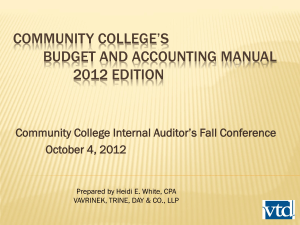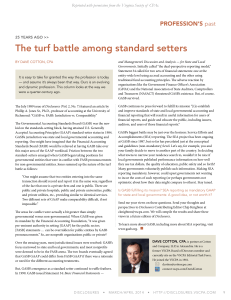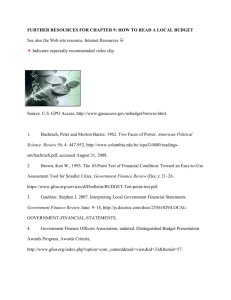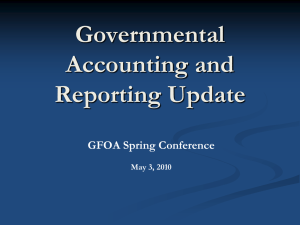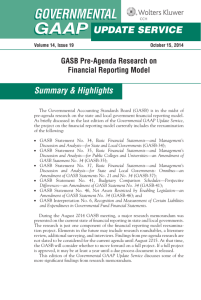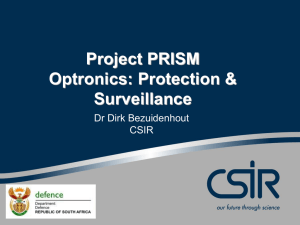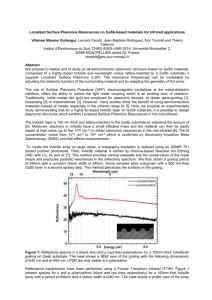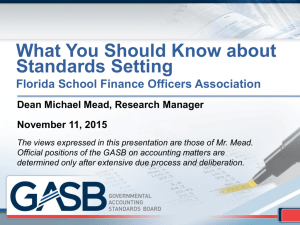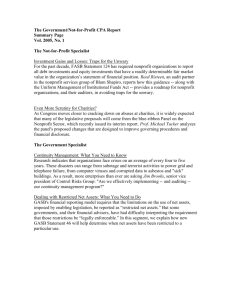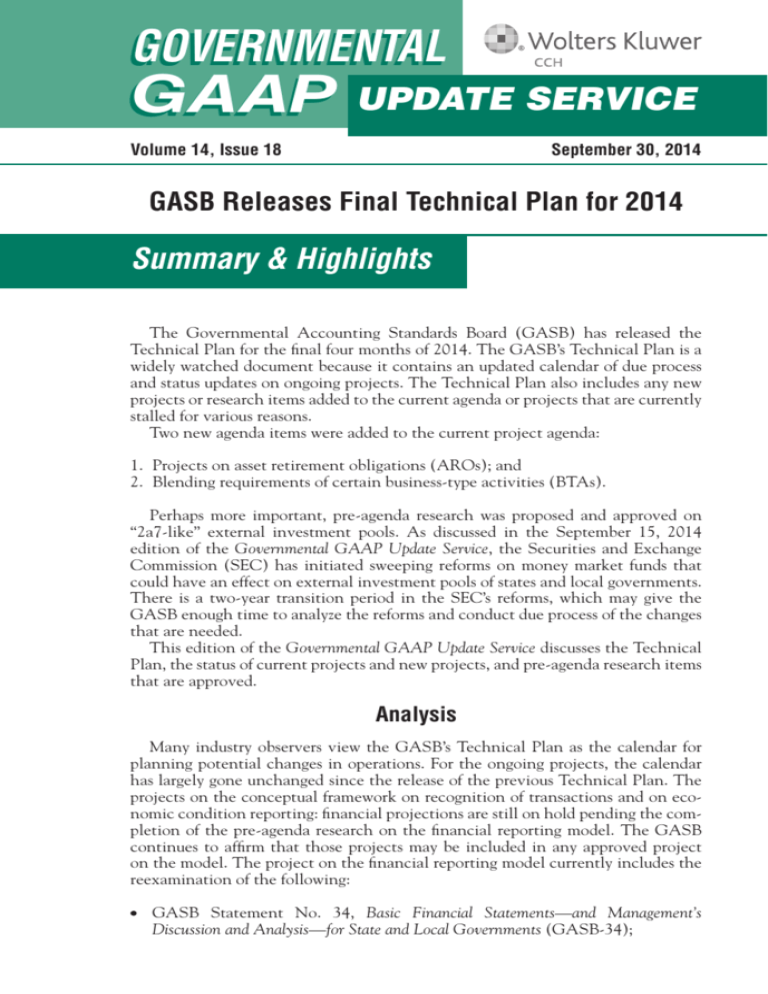
GOVERNMENTAL
GAAP UPDATE SERVICE
Volume 14, Issue 18
September 30, 2014
GASB Releases Final Technical Plan for 2014
Summary & Highlights
The Governmental Accounting Standards Board (GASB) has released the
Technical Plan for the final four months of 2014. The GASB’s Technical Plan is a
widely watched document because it contains an updated calendar of due process
and status updates on ongoing projects. The Technical Plan also includes any new
projects or research items added to the current agenda or projects that are currently
stalled for various reasons.
Two new agenda items were added to the current project agenda:
1. Projects on asset retirement obligations (AROs); and
2. Blending requirements of certain business-type activities (BTAs).
Perhaps more important, pre-agenda research was proposed and approved on
“2a7-like” external investment pools. As discussed in the September 15, 2014
edition of the Governmental GAAP Update Service, the Securities and Exchange
Commission (SEC) has initiated sweeping reforms on money market funds that
could have an effect on external investment pools of states and local governments.
There is a two-year transition period in the SEC’s reforms, which may give the
GASB enough time to analyze the reforms and conduct due process of the changes
that are needed.
This edition of the Governmental GAAP Update Service discusses the Technical
Plan, the status of current projects and new projects, and pre-agenda research items
that are approved.
Analysis
Many industry observers view the GASB’s Technical Plan as the calendar for
planning potential changes in operations. For the ongoing projects, the calendar
has largely gone unchanged since the release of the previous Technical Plan. The
projects on the conceptual framework on recognition of transactions and on economic condition reporting: financial projections are still on hold pending the completion of the pre-agenda research on the financial reporting model. The GASB
continues to affirm that those projects may be included in any approved project
on the model. The project on the financial reporting model currently includes the
reexamination of the following:
GASB Statement No. 34, Basic Financial Statements—and Management’s
Discussion and Analysis—for State and Local Governments (GASB-34);
GASB Statement No. 35, Basic Financial Statements—and Management’s
Discussion and Analysis—for Public Colleges and Universities—an Amendment of
GASB Statement No. 34 (GASB-35);
GASB Statement No. 37, Basic Financial Statements—and Management’s
Discussion and Analysis—for State and Local Governments: Omnibus—an
Amendment of GASB Statements No. 21 and No. 34 (GASB-37);
GASB Statement No. 41, Budgetary Comparison Schedules—Perspective
Differences—an Amendment of GASB Statement No. 34 (GASB-41);
GASB Statement No. 46, Net Assets Restricted by Enabling Legislation—an
Amendment of GASB Statement No. 34 (GASB-46); and
GASB Interpretation No. 6, Recognition and Measurement of Certain Liabilities
and Expenditures in Governmental Fund Financial Statements.
Findings from pre-agenda research are not slated to be considered for the current
agenda until August 2015. At that time, the GASB will consider whether to move
forward on a full project. If a full project is approved, it may be at least a year until
a due process document is released.
Status of Current Projects
Current projects that are in various stages of due process continue to be worked
on by the GASB. Exposure drafts are currently outstanding on the Fair Value
Measurement and Application project and the three related projects on postemployment benefit accounting and financial reporting:
1. Other Postemployment Benefit Accounting and Financial Reporting—Employer;
2. Other Postemployment Benefit Accounting and Financial Reporting—Plan; and
3. Pensions Not Within Statement 68 Scope.
The Fair Value Measurement and Application project is slated to have a final standard released by February 2015. The various postemployment benefit accounting
and financial reporting exposure drafts are slated to be deliberated and have final
standards issued by June 2015. The projects on reexamining the GAAP hierarchy
and the status of the Comprehensive Implementation Guide, also in the midst of a
lengthy exposure draft period, should also have final standards released by June 2015.
Other current projects are close to due process documents. The Fiduciary
Responsibilities project should have a release of a preliminary views document in
November 2014. A comment period is currently slated to February 2015. Public
hearings are scheduled for April 2015. Between April and October, the GASB will
re-deliberate the issues and an exposure draft is expected by October 2015. There
will be an additional 90-day comment period on the exposure draft with a final
standard expected by July 2016. It is unknown at this juncture when any final standard may be implemented. However, it could be speculated that an implementation period would be at least a year in order to allow governments to make changes
to contracts, accounting and financial reporting systems, and potentially laws and
regulations for fiduciary activities.
The major Leases project is on a similar trajectory. The project is being widely
watched as nearly every standard-setting organization is reissuing their standards
on leases. A preliminary views document is expected to be released by the GASB
in November 2014, at the same time as the similar document on Fiduciary Activities.
The comment period on the preliminary views document will also be from
2
©2014 CCH Incorporated. All Rights Reserved.
December 2014 through February 2015 and public hearings are expected in April
2015. Due to the potential controversy in the project, especially with for-profit
entities, it appears that an exposure draft may not be released until January 2016.
Should that occur, a lengthy exposure draft comment period could be included
to make sure that all issues are vetted. A final standard is currently expected by
November 2016.
New Projects Added
As stated above, two new projects were added. The first project will be on AROs.
This project was raised by the Governmental Accounting Standards Advisory
Council (GASAC) members who are concerned with public utility operations starting to be decommissioned. Currently, the only U.S. generally accepted accounting
principles (U.S. GAAP) that is similar to AROs is contained in GASB Statement
No. 18, Accounting for Municipal Solid Waste Landfill Closure and Postclosure Care
Costs (GASB-18), issued in 1993. In the Technical Plan, the GASB staff discusses
that the project will determine a general approach to recognition and measurement of an ARO, considering existing practice among governments and feedback
received from preparers and auditors regarding their concerns about complexity,
comparability, and the balance of costs and benefits. The project also will consider
the following issues:
Should costs, if any, associated with AROs be capitalized? If so, how should
these costs be recognized and measured?
What information about AROs should be disclosed in the notes to the financial statements?
Already, there is a reasonable amount of research because for-profit utilities
need to follow FASB Accounting Standards Codification™ (ASC) 410, Asset
Retirement and Environmental Obligations. The research performed by the GASB
staff may include ASC 410. An exposure draft is the likely first due process document released in the new project, slated for December 2015. A comment period
would last through March 2016 and a final statement may be released in October
2016.
The second approved project entails reviewing the accounting and financial
reporting for blending requirements for BTAs. In essence, the project is reexamining GASB Statement No. 14, The Financial Reporting Entity (GASB-14), and GASB
Statement No. 61, The Financial Reporting Entity—Omnibus—an Amendment of
GASB Statements No. 14 and No. 34 (GASB-61). Public hospitals, public housing
authorities, and public institutions of higher education have been asking the GASB
to review this issue for a while because there is an inconsistency in accounting and
financial reporting of some of those entity’s activities. Many of these activities are
organized in limited liability companies or partnerships in order to add or increase
services or spin off operations for legal or risk purposes. However, these companies
may still be controlled by the hospital or institution of higher education.
The GASB staff has indicated that the project may consider the following issues:
Which method of reporting component units—blended or discrete—best represents the reporting entity of certain BTAs?
Which information regarding component units (presentation or disclosure) for
BTAs would best meet financial statement user needs?
©2014 CCH Incorporated. All Rights Reserved.
3
Are the present blending criteria sufficient or are revisions necessary?
If revised or new blending criteria are considered, should additional information
be disclosed to meet the needs of financial statement users?
As indicated above, if any change is to be made, GASB-14 and GASB-61 may
need to be amended. The project is on a relatively “fast track” and an exposure draft
is expected by June 2015. Comments will be accepted through September 2015
with a final standard potentially by March 2016.
Other Ongoing Projects
Projects continue to progress on irrevocable charitable trusts and tax abatement
disclosures. The Tax Abatement Disclosure project is moving faster with an exposure
draft expected by October 2014, a comment period through January 2015, and a
final standard by August 2015. The Tax Abatement Disclosure project only entails
changes in note disclosures and no basic financial statement changes. Disclosures
may focus on abatements related to economic development. Tentative disclosures
may include:
The name and purpose of the program(s), and the taxes being abated;
The authority under which tax abatements are granted;
The criteria, if any, that make a recipient eligible to receive a tax abatement;
The manner in which the taxes are abated, including how the amount of abatement is determined and how the taxes are reduced; and
The number of abatements granted during the reporting period and the total
number of abatements in effect as of the date of the financial statements.
Public interest research groups and the media are closely watching this project. Many governments already disclose these items on a regular basis; therefore,
adding the information to the notes to the basic financial statements may not be
a large change. However, other governments may find this disclosure controversial because some governments compete with other governments for revenues as a
result of new economic development. On the other hand, many observers find that
these programs are wasteful, unrecognized expenditures of tax revenues that could
better serve more urgent needs.
The project on irrevocable charitable trusts is also a focus of public institutions
of higher education and hospitals. Many of these institutions receive charitable
trust revenues. Current GASB standards contain minimal information on charitable trust and split-interest reporting. The GASB is considering the recognition,
measurement, and disclosure of beneficial interests in resources held by third parties that are outside the reporting entity and if expanded guidance is needed on
recognition, measurement, and disclosure for split-interest agreements for which
the government or its component units administer the assets. An exposure draft is
expected in May 2015 with a comment period through the summer of 2015. A final
statement is expected in January 2016.
New Pre-Agenda Research to Commence on 2a7 Pools
As previously discussed, the GASB is quickly revisiting the measurement issues
associated with external investment pools and comparing current U.S. GAAP contained in GASB Statement No. 31, Accounting and Financial Reporting for Certain
4
©2014 CCH Incorporated. All Rights Reserved.
Investments and for External Investment Pools (GASB-31), as amended. The GASB
may be under pressure from state and local government treasurers that may not
want to have a split in accounting and financial reporting guidance between GASB
standards and SEC compliance. Audit issues may be raised because treasurers may
need to represent that they have complied with applicable laws and regulations.
Yet, to comply, the treasurer may have to change the way that external investment
pools are operated, splitting from the 2a7-like provisions currently used. Findings
of the pre-agenda research are to be presented to the GASB by December 2014.
Conclusion
Over the next four months, two preliminary views documents (Leases and
Fiduciary Activities) and an exposure draft (Tax Abatement Disclosures) are slated to be
released by the GASB. Public hearings will occur on all three exposure drafts related
to postemployment benefits accounting and financial reporting. The fair value measurement and application exposure draft should be finalized by February 2015. The
postemployment benefits documents are expected to finalize by June 2015, as will
the reexamination of the GAAP hierarchy, an updated implementation guide, and
perhaps an exposure draft on blending requirements for certain BTAs. By that time,
an additional exposure draft may be released on irrevocable charitable trusts. By the
end of next summer, we could have new note disclosure principles for tax abatements.
The GASB and its staff are busy—too busy to some. However, the GASB only
reacts to changes in operations that are raised by stakeholders. Yes, there are seemingly
large changes looming in leases, fiduciary activities, and conforming OPEB standards
to the pension standards currently being implemented. However, none of these are as
large as implementing the current pension standards or what occurred implementing
the new financial reporting model a decade or so ago. What is contained in a set of
basic financial statements will need to be tweaked on a regular basis. Preparers, auditors, and other stakeholders need to realize that change is constant and planning for
the changes is among one of our more important functions as practitioners.
About the Author
Eric S. Berman, MSA, CPA, CGMA, has over 24 years of governmental
accounting and auditing experience and is a partner with Eide Bailly LLP.
Previous to Eide Bailly LLP, he was a quality control principal with a public
accounting firm in California. His public sector experience includes being a
Deputy Comptroller for the Commonwealth of Massachusetts from 1999 to
2010, and the Chief Financial Officer of the Massachusetts Water Pollution
Abatement Trust from 1994 to 1999. Eric is a licensed CPA in Massachusetts.
He obtained an M.S. in Accountancy from Bentley University. Eric
recently represented the Association of Government Accountants (AGA)
as the Vice Chairman of the Government Accounting Standards Advisory
Council to GASB. He currently chairs the AGA’s Financial Management
Standards Board. He also is a previous chair of the American Institute of
Certified Public Accountants (AICPA) Governmental Performance and
Accountability Committee and is a former member of the AICPA’s State and
Local Government Expert Panel. Eric is frequently called upon to consult and
train state and local governments throughout the country on governmental
accounting and auditing.
©2014 CCH Incorporated. All Rights Reserved.
5
LEADING ACCOUNTING AND AUDIT INFORMATION
AND TOOLS FOR PROFESSIONALS
CCH, a part of Wolters Kluwer, offers a suite of accounting and
audit information and products featuring in-depth analysis, guidance,
and solutions in a full range of media—from guides, practice manuals,
and treatises to journals, newsletters, and Internet research libraries.
Make CCH your source for accounting guidance with comprehensive,
timesaving products, including:
• Accounting Research
Manager
• Governmental GAAP
Practice Manual
• GAAP Guide
• Knowledge-Based Audits
of State and Local
Governments with Single
Audits
• Governmental GAAP
Guide
To order or for more information on these and other CCH products
and services, call 1-800-248-3248 or visit the CCH Online Store at
CCHGroup.com.
6
©2014 CCH Incorporated. All Rights Reserved.
CCH LEARNING CENTER
CCH’s goal is to provide you with the clearest, most concise, and
up-to-date accounting and auditing information to help further your
professional development, as well as a convenient method to help you
satisfy your continuing professional education requirements. The CCH
Learning Center* offers a complete line of self-study courses covering
complex and constantly evolving accounting and auditing issues. We are
continually adding new courses to the library to help you stay current
on all the latest developments. The CCH Learning Center courses are
available 24 hours a day, seven days a week. You’ll get immediate exam
results and certification. To view our complete accounting and auditing
course catalog, go to: http://cch.learningcenter.com.
* CCH, a part of Wolters Kluwer, is registered with the National Association of State Boards
of Accountancy (NASBA) as a sponsor of continuing professional education on the National
Registry of CPE Sponsors. State boards of accountancy have final authority on the acceptance
of individual courses for CPE credit. Complaints regarding registered sponsors may be
addressed to the National Registry of CPE Sponsors, 150 Fourth Avenue North, Nashville,
TN 37219-2417. Telephone: 615-880-4200.
* CCH, a part of Wolters Kluwer, is registered with the National Association of State
Boards of Accountancy as a Quality Assurance Service (QAS) sponsor of continuing
professional education. Participating state boards of accountancy have final authority on
the acceptance of individual courses for CPE credit. Complaints regarding QAS program
sponsors may be addressed to NASBA, 150 Fourth Avenue North, Suite 700, Nashville,
TN 37219-2417. Telephone: 615-880-4200.
©2014 CCH Incorporated. All Rights Reserved.
7
AC C OUNTING RE SE A RCH MA NAGER®
Accounting Research Manager is the accounting industry’s largest and most
comprehensive online database, providing easy access to objective and insightful
government, accounting, auditing, and SEC information. While other research
tools simply summarize the authoritative literature, leaving you to decipher oftencomplex information, Accounting Research Manager goes the extra mile to give
you the clearest possible picture. We bring clarity to your government and financial
reporting research.
The Government Library
The Accounting Research Manager Government Library provides one-stop
access to governmental authoritative and proposal stage literature including:
• GASB (Governmental Accounting Standards Board) Statements &
Interpretations, Technical Bulletins, Implementation Guides & related
proposal stage literature
• GAO (Government Accountability Office) Governmental Auditing
Standards, Financial Audit Manual
• OMB (Office of Management and Budget) Circulars, Compliance Supplements
The Government Library also offers in-depth, interpretive guidance. Users can
access our Government titles that include the Governmental GAAP Guide,
Governmental GAAP Practice Manual, Knowledge-Based Audits of State and Local
Governments with Single Audits, and the Governmental GAAP Update Service.
Learn more about Accounting Research Manager and request your free trial at
www.accountingresearchmanager.com.
Eric S. Berman, partner with Eide Bailly, authors articles twice a month via CCH.
For more information on subscribing to the service allowing you to receive these
articles upon release, Click here
He also authors CCH's Governmental GAAP Library which is available in print or
e-book
8
©2014 CCH Incorporated. All Rights Reserved.
MGGS

